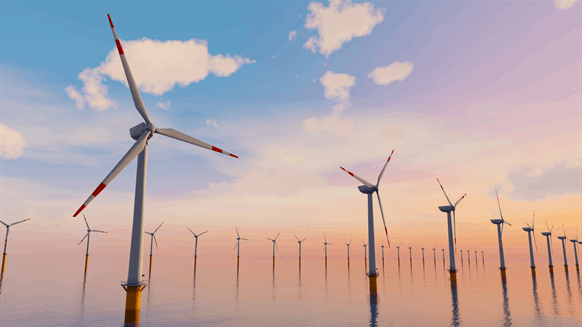UK Wind Capacity Overtakes Gas for First Time: Report

Wind for the first time has accounted for the biggest share in the power capacity mix in the United Kingdom, after more than a century of fossil fuel dominance.
That’s according to the latest Electric Insights report for the second quarter from Drax Group plc, which said that the nation’s fleet of wind farms reached 29.7 gigawatts (GW) of capacity in June, overtaking combined cycle gas power stations for the first time and making the UK the fifth country in the world to have wind power as the leading electricity generator, joining Denmark, Spain, Ireland, and Finland.
Gas had been Britain’s largest source of power capacity for the last 10 years, and before that coal was the leader for the past decades. Since 2011, coal capacity plunged as coal-fired power plants retired from 28 GW to just two GW, the report said. Dozens of gas-fired power stations were built during the 1990s and their capacity reached a peak of 30 GW in 2010. Since then gas has been in a slow decline, with no new fossil fuel power stations built since 2016, the report noted.
On the other hand, Britain’s wind capacity has tripled over the past decade, divided almost equally between onshore and offshore capacity with 14.1 GW and 13.8 GW, respectively. Around half of the projects are in England and its seas, while three-eighths are in Scotland and one-eighth are in Wales, the report said. Around $74.6 billion (GBP 60 billion) has been invested in wind power over the past 20 years in Britain, mostly by pension funds and other large institutional investors, according to the report.
Looking ahead, the report predicts Britain’s wind capacity will continue growing at pace, as 6.7 GW of wind farms are currently under construction. “Scotland’s largest offshore farm, Seagreen, is nearing completion with other large projects underway off the coast of East Anglia and on Dogger Bank. Beyond this, the UK has a staggering 98 GW of offshore wind in planning, a pipeline that is the second largest in the world (behind only China), ahead of the United States and all European countries”, the report noted.
Meanwhile, electricity generation from fossil fuels in the UK fell to its lowest levels since the COVID-19 lockdown. Fossil fuels produced 22.2 terawatt-hours of electricity over the last three months, just over a third of total electricity demand, the report noted. Output from gas-fired power stations fell by 23 percent compared to the second quarter of 2022, and output from coal fell by three-quarters to its lowest levels on record.
The key driver for declining fossil fuel use was “the reversal of fortunes on the continent, leading to a reversal of flows across the interconnectors”, the report said, explaining that “with gas stores replenished and some of France’s nuclear fleet coming back online, Britain’s neighboring countries were less short on power”. Since last year, Britain moved from exporting 1.7 GW to importing 3.4 GW, which is a swing of over five GW, the report noted. Carbon emissions from electricity production fell to below 10 million metric tons of carbon dioxide over the quarter for only the second time ever, with the previous instance being during the COVID lockdown, it said.
In terms of electricity production, in the second quarter, gas overtook wind to be the largest source of electricity produced, making up 35.2 percent of the energy mix compared to wind’s 21.3 percent. This was in part driven by low wind speeds, meaning wind farms produced one-sixth less electricity than they did last year, despite capacity growing by 10 percent, the report stated.
The quarterly Electric Insights report was established by energy firm Drax to help inform and enlighten the debate on Britain’s electricity. Since 2016, it has been delivered independently by a team of academics at Imperial College London using data courtesy of Elexon, National Grid, and Sheffield Solar.
To contact the author, email rteodoro.editor@outlook.com
What do you think? We’d love to hear from you, join the conversation on the
Rigzone Energy Network.
The Rigzone Energy Network is a new social experience created for you and all energy professionals to Speak Up about our industry, share knowledge, connect with peers and industry insiders and engage in a professional community that will empower your career in energy.
- OPEC Fund Chips In for $200MM Financing for Egypt Food Security
- Chevron Australia, Striking Workers Agree to Terms Proposed by Tribunal
- UK Offshore Wind Industry Risks Cancellations: Hedge Fund Chief
- Analysts Examine USA Gas Inventory
- BP, Pertamina Eye CCUS, Blue Ammonia Projects in Indonesia
- Vietnam Upstream Sector Outlook Brightening
- Union Jack Acquires Interest in German Assets Through Beacon
- California Sues Big Oil Demanding Damages, Relief
- Oil Drops as Fed Signals Further Rate Hikes
- North America Breaks Rig Loss Streak
- Who Produced the Most Natural Gas in 2022?
- Cocaine Is Set to Overtake Oil to Become Colombia's Main Export
- Brent Oil Price Highly Likely to Move Above $100
- EIA Bumps Up USA Diesel Price Forecast
- Aramco, ExxonMobil Chiefs Insist Oil Needed in Energy Transition
- Shell, BP, Eni Accept Licenses for First Ever UK Carbon Storage Round
- Gazprom Delivers LNG to China via Arctic Route for First Time
- Saudi Crude Oil Exports Plummet
- What Would Happen to the Oil Price If OPEC+ Went into Max Production Mode?
- Oil Market is Bewildered
- Market Expert Says $100 Oil Is in Sight
- Big Tech Is Coming for Oil Patch Workers
- BMI Reveals Latest Brent Oil Price Forecasts
- For Global Oil Markets, a USA-Iran Deal Is Already Happening
- Saudi-Russia Move Can Only Result in One Thing
- BP CEO Resigns amid Probe into Relationships with Colleagues
- California Sues Big Oil Demanding Damages, Relief


